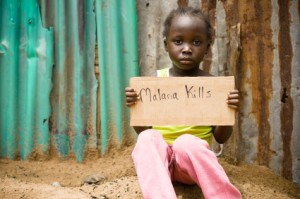
Global malaria eradication is possible within a generation, but only with renewed focus, new tools and sufficient financial support, according to a paper published in The Lancet by the Global Health Group’s (GHG) Malaria Elimination Initiative (MEI) at UC San Francisco (UCSF).
The paper examines the progress that 351 countries with low malaria transmission are making to eliminate the disease entirely from within their borders. Countrywide elimination, a precursor of global eradication, is now seen as an attainable goal for most national malaria programs, and countries are working collaboratively to end malaria transmission in their regions.
“Eradicating malaria will require nothing short of unwavering support at all levels—national, regional, and global. With intense focus, new tools, and adequate financial resources, a malaria-free world is possible within a generation,” said Sir Richard Feachem, KBE, FREng, DSc(Med), PhD, director of the UCSF Global Health Group and the paper’s senior author. “The malaria map is shrinking rapidly. More than 20 countries are on track to eliminate by 20201 and over 60 can do it by 2030. We cannot let up now. To achieve the ambitious but attainable goal of malaria eradication by 2040, the targets we set must be as big and bold as our aspirations.”
As World Malaria Day approaches on April 25, Feachem said it is important to remember that malaria was once a leading cause of death and illness in nearly every country in the world. Since 2000, great progress has been made around the globe, driven largely by the progress made by the eliminating countries. In these malaria-eliminating countries, malaria cases declined 91 percent, from 1.6 million cases to 150,000, while malaria deaths dropped 81 percent between 2000 and 2014.2 The list of eliminating countries continues to grow as nations and regions adopt ambitious goals to eliminate the disease, rather than only controlling it and allowing transmission to continue.

More than half of the world’s countries have already eliminated malaria. Between 2007 and 2013, four countries (Armenia, Morocco, Turkmenistan, and United Arab Emirates) were certified as malaria-free by the World Health Organization (WHO), and eight more have prevented the reintroduction of malaria for at least three years (Argentina, Egypt, Georgia, Iraq, Kyrgyzstan, Oman, Syria, and Uzbekistan). Five others have interrupted local transmission (Azerbaijan, Costa Rica, Paraguay, Sri Lanka, and Turkey). As an example of recent success, Sri Lanka reduced its local malaria cases from over 200,000 in 2000 to zero by 2013. Sri Lanka will be applying for WHO malaria-free country certification later this year.
However, this progress cannot be taken for granted. The greatest threat to malaria elimination, according to the paper, would be a reduction of the political and financial commitment required to eliminate malaria and prevent reintroduction. In the malaria-eliminating countries, nearly 80 percent of elimination funding comes from national governments, but this financing is at risk of being diverted to other disease priorities perceived as being more urgent. External aid has been on the decline for eliminating countries, with multi- and bilateral donors tending to support low-income, high-burden malaria countries in an effort to reduce malaria cases rather than end transmission. Eliminating countries are expected to face an overall 31 percent decline in national funding from the Global Fund, the largest financer of malaria.1 Further, 15 of the malaria-eliminating countries are now upper-middle-income and will be expected to close the financing gap with domestic funding. Other challenges to malaria elimination are technical and include malaria crossing borders, growing drug and insecticide resistance, increase in zoonotic malaria, and limited treatment options for the malaria parasite, Plasmodium vivax.
The paper describes the critical components to put countries on the path to malaria eradication. These include strong and sustained funding commitments, a global endorsement of the eradication agenda, and robust regional collaborations on elimination. Annual investments will need to increase to at least $6.4 billion by 2020 to continue progress in all malaria-endemic countries, according to the Roll Back Malaria Partnership’s Action and Investment to defeat Malaria 2016-2030 (AIM) – for a malaria-free world. A global endorsement of an eradication goal is needed to help generate the enthusiasm and momentumnecessary for countries toeliminate the disease from their borders. Resilient regional collaborations will be required to achieve the ambitious regional goals, including elimination in Mesoamerica-Hispaniola (2020), Asia Pacific (2030), and southern Africa (2030).
To overcome technical challenges, the paper calls for malaria-eliminating countries, neighboring countries, donors, and partners to prioritize collaboration, funding, and rigorous research into innovative new tools and elimination strategies. Specific enabling factors needed to achieve global eradication include:
Building the evidence base through research, knowledge sharing, monitoring, and evaluation.
Identifying the most effective mix of strategies and interventions needed to achieve elimination in various settings.
Empowering program managers to select the most appropriate combination of interventions – such as a strong surveillance system and targeting of interventions that are most effective in their setting.
Providing flexible management, capacity building, and leadership training for surveillance and response officers.
Supporting predictable and long-term funding for low-transmission programs.
Read the paper and listen to Sir Richard Feachem’s podcast here:
http://www.thelancet.com/journals/lancet/article/PIIS0140-6736(16)00230-0/abstract
Notes to Editors
Due to the rapid progress being achieved, the number of malaria-eliminating countries is regularly updated. At the time of the paper’s development in 2015, 35 countries were working toward elimination goals with target end dates ranging from 2013-2035. Today, 24 countries are working to eliminate malaria by 2020. The Global Fund analysis was done on the 2010 list of 34 eliminating countries.
This paper was written with 2014 World Malaria Report (WMR) data. Since this paper was accepted for publication, the 2015 WMR data have been published, showing even more progress in reducing malaria cases and deaths in the 35 malaria eliminating countries. This release uses the updated 2015 WMR data. A comparison is included below:
WMR 2014
(2000-2013)
In malaria eliminating countries:
cases down 90% from 1.6 million to 160,000 reported deaths decreased by 87%
WMR 2015
(2000-2014)
In malaria eliminating countries:
cases down 91% from 1.6 million to 150,000 reported deaths decreased by 81%
Elimination and Eradication
The words elimination and eradication are often confused and used incorrectly. Elimination refers to the ending of malaria transmission within a country or defined geographical area. Thus, the United States eliminated malaria in 1952, Turkmenistan eliminated malaria in 2010, and China and Swaziland (along with more than 30 other countries) are working on eliminating malaria now.
The word eradication refers to the complete removal of the malaria parasite from the human species. In other words, no more malaria is transmitted anywhere in humans. Elimination, country by country, is a critical step down the road towards eventual global malaria eradication.
About the UCSF Global Health Group’s Malaria Elimination Initiative
The UCSF Global Health Group is an ‘action tank’ dedicated to translating new approaches into large-scale action to improve the lives of millions of people. Launched in 2007, the UCSF Global Health Group’s Malaria Elimination Initiative (MEI) believes that global eradication of malaria is possible within a generation.
Working with forward-thinking partners at global, regional, and national levels, the MEI accelerates progress by conducting operational research to improve surveillance and response, determining the costs of elimination, and strengthening political and financial commitment to shrink the malaria map. For more information on malaria elimination, please visit: http://www.shrinkingthemalariamap.org or http://globalhealthsciences.ucsf.edu/global-health-group/malaria-elimination-initiative.
About UCSF: UC San Francisco (UCSF) is a leading university dedicated to promoting health worldwide through advanced biomedical research, graduate-level education in the life sciences and health professions, and excellence in patient care. It includes top-ranked graduate schools of dentistry, medicine, nursing and pharmacy; a graduate division with nationally renowned programs in basic, biomedical, translational and population sciences; and a preeminent biomedical research enterprise.
It also includes UCSF Health, which comprises top-ranked hospitals, UCSF Medical Center and UCSF Benioff Children’s Hospitals in San Francisco and Oakland–and other partner and affiliated hospitals and healthcare providers throughout the Bay Area. Please visit www.ucsf.edu/news.

